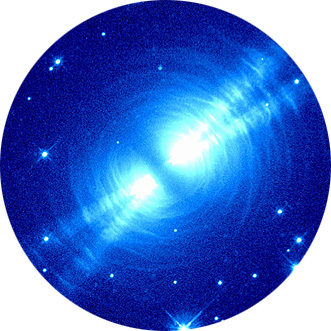UW Jumps into the Hunt for Extraterrestrial
Life, But the Quarry Is Not Little Green Monsters or Cute ETs.
By Vince Stricherz
John Delaney is convinced there is life beyond Earth.
Last fall, the celebrated University of Washington oceanography
professor told new freshmen he fully expects extraterrestrial life to be
discovered within their lifetimes, which "will be the single-most profound
event up to that point (in history), because that will tell us we are not
alone."
Delaney and a host of UW scientists are ready to embark on a program
that will train people to find life in outer space. This fall they will
begin the first doctoral program in the quickly emerging field of astrobiology.
Planets and moons in our own solar system will draw the most interest as
the places where such life is most likely to be found, but the training
ground will be right here on Earth.
This picture of the "Egg Nebula" was taken
by the Hubbel Space Telescope. Image courtsey of JPL/NASA.
Study will focus on tiny organisms that love extreme settings the
high pressure and 500-plus-degree Fahrenheit conditions in undersea, hydrothermal
vents; the frigid temperatures and high salt content in pockets of brine
deep within the Arctic ice pack; boiling hot springs; and barren rocks a
half-mile deep in volcanic basalt formations.
The course work will be highly interdisciplinary. Graduates will receive
degrees in any of 11 areas, from oceanography to chemistry to history, with
an endorsement indicating a specialty in astrobiology.
If the whole idea sounds a bit far-fetched, consider this: Scientists
already know about creatures that exist and thrive in some of the most extreme,
forbidding environments right here on Earth.
Exotic-looking tube worms, unique crabs, strange shrimp and giant clams
are among the species that live in a complex ecosystem in hydrothermal vents
more than 1.5 miles below the ocean surface, where sunlight doesn't penetrate.
Instead of solar energy, their world is fueled by a unique chemical synthesis
triggered by hot water boiling out from the Earth's crust. The interiors
of sulfide chimneys built by these vents protect a little-understood but
prospering population of heat-loving microbes that include the most primitive
creatures known.
Similarly, microbes live within the boiling waters of hot springs such
as in Yellowstone Park. Other organisms thrive in small pockets of salty
soup locked within polar ice. As the water freezes, that process itself
drives salt and the organisms from the ice into the water, making
the remaining liquid so salty it won't harden, even at temperatures well
below freezing. Then there are basalt formations such as those in Eastern
Washington, where microscopic creatures have found ways to survive and flourish
deep inside, drawing energy from the natural weathering of the rock.
Does any of that sound like outer space? Many scientists are betting
it does. Most people think of Mars as a barren planet, but there is evidence
of subsurface water. NASA in December
launched a mission trying to find that vital liquid of life. Europa, an
icebound moon of Jupiter, is providing new clues that there might be volcanoes
and liquid water beneath its frozen cloak. In October, scientists began
seeing similar signs on Callisto, an icy sibling of Europa. The essentials
for life are liquid water and available energy, which can be harvested from
a number of sources other than sunlight, including chemical, thermal and
tidal processes.
"The last five or ten years have really pushed the envelope in terms
of the extreme conditions in which life can exist," says Astronomy
Professor Woodruff Sullivan, a co-director for astrobiology.
It's not just the discovery of life in those extreme conditions on Earth,
but a growing understanding of how intemperate conditions must have been
when life emerged here. Earth itself is 4.6 billion years old and scientists
say life came on the scene some 3.5 billion years ago on a hot planet bombarded
daily by asteroids. After that, it took nearly three billion more years
and many changes in the Earth's atmosphere and surface before
the Cambrian explosion brought forth complex life forms, crustaceans and
fish with millions of cells. | 
